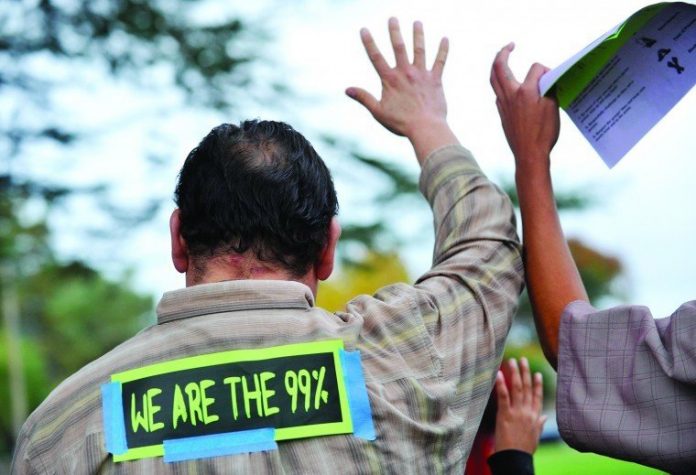From students to lawyers, parents to the unemployed – Friday’s
Occupy Gilroy crowd was a stratified bunch with a unified voice:
Home foreclosures, the rising costs of higher education, the lack
of good jobs, seemingly endless budget cuts, tax breaks for
billionaires: Gilroy’s “99 percent” say they won’t stand for
it.
From students to lawyers, parents to the unemployed – Friday’s Occupy Gilroy crowd was a stratified bunch with a unified voice: Home foreclosures, the rising costs of higher education, the lack of good jobs, seemingly endless budget cuts, tax breaks for billionaires: Gilroy’s “99 percent” say they won’t stand for it.
“This horrendous foreclosure crisis has resulted in so many homes that are unoccupied, and the way to reverse that is to occupy,” said Paul Reagan, 54; a network engineer in Silicon Valley who has lived in Gilroy with his wife, Nancy Reagan, 60; for 25 years.
Paul was one of a dozen attendees who addressed the crowd during a general assembly held at 4 p.m. at Miller Park on 7851 Carmel St.
“These financial institutions shouldn’t be getting bailouts,” he added. “They should be getting bail.”
Under stormy skies, cold weather and intermittent drizzles, about 70 people showed up between the hours of 4 and 6 p.m. for the first Occupy event staged locally in Gilroy.
The gathering is one of hundreds branching from the original movement on Wall Street, which began Sept. 17 in Manhattan.
There are no definitive leaders or official set of demands – rather, unrest over a gamut of grievances such as corporate greed, economic inequality and the influence of corporate lobbyists on government.
Supporters camp out on public property, tout signs and stage organized assemblies, or “occupations,” where participants engage in large group discussions and express their views through hand signals.
The cause has spread nationwide to more than 200 cities including Hollister, which held its own protest Oct. 13.
After taking a head count Friday, supporter Dom Payne, who sits on the Gilroy Unified School District Board of Trustees, said “I just was hoping for 20 to 30 people.”
The healthy turnout, he noted, “shows you where people are at.”
En route down Carmel to First Street, drivers of cars honked their horns or made peace signs at the roving Occupy crowd.
A watchful group of five motorcycle units from the Gilroy Police Department kept vigil for the length of the event.
Having caught wind of the event ahead of time, Bank of America (which has hours of operation from 9 a.m. to 6 p.m. on Fridays) was still open for business at 5:20 p.m., but with battened-down hatches.
Michael Jenkins, a Banking Center Manager, stood by the entrance, unlocking the glass doors for individuals as they came and went. Occupiers did not attempt to go inside; rather, they lined the sidewalk in front of the bank’s parking lot.
Jenkins explained he was not at liberty to speak with the media, but was overheard telling a customer the upped security was “because of the protest.”
Contrary to the seemingly younger demographic that appears to constitute a majority of the Occupy populations in larger cities such as Oakland and Manhattan, Gilroy’s participants ran the gamut in age and background.
Rather than speak, local acoustic guitarist Tim Moon used his floor time to play “This Land is Your Land,” while the crowd sang along.
Gavilan student Lucia Leal, 25, said she resonates with Occupy’s stance against corporate greed and economic inequality after her family lost their house four years ago.
“We begged Bank of America for three years for a short sale,” she recalled, explaining how, after her father lost both of his part-time jobs, her parents were unable to make payments on their mortgage. The family dealt with constant threats of foreclosure, she said.
A handful of participants opened up about their struggles with joblessness.
Attendee Reymundo Armendariz underscored the fact “people who went to school and made the right choices” are still struggling, “and that’s troubling,” he said.
A graduate of California State University, Monterey Bay, Armendariz majored in political science. His wife, Makeba Armendariz, studied psychology.
Both worked for different organizations in the nonprofit sector.
Both were laid off in June.
The parents of two daughters ages 16 and 10, Reymundo and Makeba fell behind on their rent by four months.
Jesus Becerra, similarly, was recently laid off from his job at another Gilroy nonprofit organization, Chamberlain’s Mental Health Services.
The 30-year-old said it’s time for someone to stand up to corporations, as “they have too much power in the government.”
Occupy Gilroy organizers had initially discussed staging gatherings twice a month, the question of holding a weekly event was raised before the crowd during the assembly – and received by an overwhelming response of “spirit fingers” (one of Occupy Gilroy’s established hand signals for “agree,” in where participants put both hands in the air and wiggle their fingers).
While Occupy Gilroy identifies itself as “horizontal in structure, making decisions by consensus,” the event’s logistics were co-organized by GUSD trustee Payne – a father of five and part-time instructor of the non-credit program at Gavilan College whose English language and living through learning classes were canceled this year.
Payne got involved with Occupy Gilroy after making contact with 17-year-old Tomas Hernandez, a senior at Christopher High School who co-organized the event. He also started both the Occupy Gilroy and Occupy San Jose Facebook pages.
“I’m happy with the turnout,” said Hernandez, gazing at the crowd after it marched from Miller Park to downtown Gilroy and gathered outside Bank of America at 7825 Monterey St.
For the high school senior gearing to graduate next spring, he’s wincing at the gargantuan cost of higher education. As tuition rates continue to rise and jobs remain scarce, Hernandez isn’t giddy about saddling himself with insurmountable debt in exchange for a diploma.
“I don’t want to be in that situation,” he resolved.
For him, Payne said the act of physically occupying isn’t as important so much as the conscious effort of “intellectual occupation.”
Payne said it’s time for the apathy to move away, so people can meet, have discussions and not feel like their efforts “aren’t going to change anything, or like it doesn’t matter.”
Currently, Occupy Gilroy has identified four key concerns:
– “There should be a constitutional amendment that disallows acorporation to be defined as a person.”
– “There should be taxation reform so that all income bracketsare taxed fairly.”
– “There should be affordable college education so that weensure the future of our children.”
– “Banks should be more regulated with laws such as TheGlass-Steagall Act.” (This legislation made several significantchanges in the federal regulation of banks; primarily theseparation of commercial banking from investment banking).















